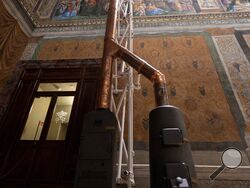Stoves used in a complex, but not quite ancient, tradition have arrived in the Sistine Chapel in Rome.
In a few days, they will be used to generate smoke that will mark the progress of the conclave in its mission to choose a new pope.
Workers have been preparing for the meeting of cardinals, set to begin May 7, which will end with the election of a new pope. Pope Francis died April 21 at the age of 88.
Photos released by the Vatican Media show two stoves and a series of chimney pipes installed within the Sistine Chapel and workers installing a chimney on the roof.
The conclave is expected to last a few days, during which time the cardinals will cast secret ballots. If one candidate for pope doesn't receive the required two-thirds vote, the cardinals will send up black smoke to tell the world a pope hasn't been chosen yet. Once the new pope is chosen, white smoke will tell onlookers of the news.
Here's how they do it:
Significance of black and white smoke
On the first day of the conclave, cardinals will cast one vote. If a pope isn't chosen, they will begin again the next day and cast up to four votes each day until a new pope is chosen. Twice each day, at about noon and 7 p.m. local time, the smoke will appear from a chimney. Black means the votes were inconclusive. White means there is a new pope.
For each round of voting, the cardinals will fold their ballots twice and drop them into a chalice, according to the United States Conference of Catholic Bishops. The votes are counted by cardinals selected to record the votes.
If they are inconclusive, the ballots are placed into a stove and burned. A second stove helps to send up the puffs of black or white smoke.
How is the smoke created?
During last conclave in 2013, which ended with the election of Francis, the black smoke was a mixture of potassium perchlorate, anthracene (a component of coal tar) and sulfur. The white smoke was produced using potassium chlorate, lactose and chloroform resin.
The once-mysterious recipe for the smoke was unveiled in 2013, The New York Times reported then.
Use of 2 stoves, chemicals is relatively recent
The cardinals' method for creating the smoke evolved into the use of cartridges containing the chemicals after previous mishaps. In 1958's conclave, when the black smoke was made by adding damp straw to the burned ballots, the straw's failure to ignite caused several false alarms when the smoke first appeared white, The Times reported.
After that fiasco, they tried smoke bombs, which made a clearer color but filled the chapel with smoke, NBC News reported. They also tried military flares and chemical additives that sickened the cardinals. The cartridges were first used in 2005.
NBC also noted the tradition of white or black smoke isn't particularly ancient and dates back to the early 1900s.

